With companies using an average of 112 SaaS apps, in 2023 integration isn’t optional. It is, in fact, essential for streamlining tools, cutting waste, and ensuring each application delivers measurable value.
But here’s the issue:
Many software tools collect lots of customer data due to frequent customer interaction with these apps.
As a result, you end up with scattered data across multiple systems and applications, which could lead to data accuracy issues. With this, maintaining a cohesive and accurate view of business and customer data is almost impossible.
This is where CRM integration steps in to help you solve the issue of data silos and fragmentation. Not only that, CRM integration helps solve the issue of data accuracy across disparate systems and multiple departments.
The good news?
With the right strategy, CRM integration is more straightforward than most business owners think, and the benefits start showing up immediately.
This article helps you understand the process of CRM integration. It highlights the most essential CRM integrations your business needs and offers guidance on their implementation.
What Is Customer Relationship Management (CRM) Integration?
Simply put, customer relationship management integration is a process that helps create seamless data integration between your CRM tools and other systems or software tools. It creates a seamless data flow between your CRM software solution and technology stack.
For instance, any changes you make to the data in your lead management software solution are reflected in the CRM data, and vice versa. This ensures all functions in the business are using similar and current data.
Also Read:
6 Crucial Benefits of CRM Integrations
CRM integration can enhance the overall efficiency and effectiveness of your business processes.
CRM integration offers myriad benefits, such as improved efficiency by automating manual processes. It also enhances customer experiences and provides actionable insights for sales reps.
Let’s look at some key benefits of CRM integration in detail.
1. Improved Efficiency
CRM integrations help automate processes by enabling automatic data synchronization between your CRM and other systems.
This increases efficiency within your business in several ways:
- It eliminates the manual processes involved in your CRM system, such as data entry, reducing the risk of errors and allowing your team to focus on more high-value tasks
- Automatic data synchronization reduces the likelihood of errors associated with mismatched records and outdated data
- It gives employees centralized access to all company and customer records from a central location. It reduces data silos and enhances collaboration among different departments. This enables a more unified and coordinated approach to customer interactions.
2. Personalized Customer Experiences
Over 56% of consumers become repeat buyers after a personalized customer experience with your brand.
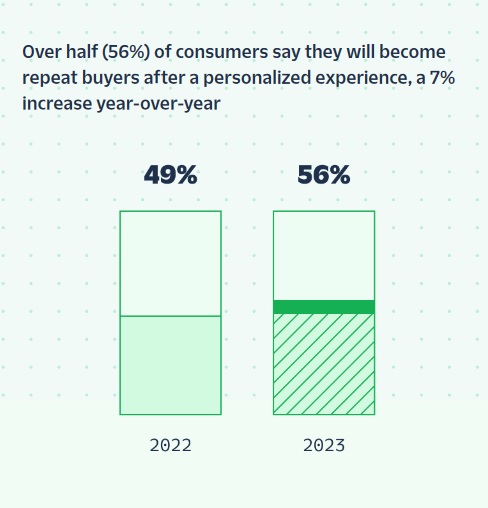
Image via Twilio Segment
On the other hand, 27% of Gen Z shoppers will stop shopping with your business and share negative experiences with others if they have an impersonal customer experience.
Such is the power of a personalized customer experience.
CRM integration centralizes and updates the complete data related to your customer interactions. Also, integrated CRM platforms help deliver personalized experiences across various touchpoints, including ecommerce and social media channels.
What’s more? It gives frontline employees a unified view of customers, enabling them to create personalized customer experiences, such as:
- Synchronizing data of past interactions or purchases
- Making customized product or service recommendations based on purchase history
- Providing proactive solutions based on anticipated customer needs
- Using the preferred communication channels to interact with customers
- Providing exclusive offers and discounts based on a customer’s loyalty
- Acknowledging important milestones, such as birthdays
3. Increased Sales and Revenue
CRM integration with marketing automation systems creates a more streamlined lead management process.
This can help sales reps or teams receive qualified leads in real-time, reducing lead response time. With this, they can quickly prioritize and act on sales opportunities and drive future sales.
In addition, a centralized source of customers’ transaction history data makes it easy for your sales team to suggest hyper-relevant upsells and cross-sells. It also helps to maximize customer lifetime value.
Also Read:
4. Enhancement of Customer Data Analysis
One of the main benefits of CRM software is that it enables accurate sales pipeline forecasting and data-driven marketing campaigns.
Analyzing data from integrated systems can help you optimize pricing strategies, manage inventory, and enhance your overall business intelligence capabilities.
It consolidates comprehensive customer data from various departments to provide valuable insights into customer behavior and preferences. These insights enable the following:
- Drive data-driven decision-making
- Effective sales, marketing, and customer service
Here are some practical examples:
- With integrated CRM systems, you can identify at-risk customers and implement retention strategies to retain them
- An integrated CRM system will help you stay up to date with customer updates or needs. You can use this knowledge to improve product development
- It enables you to analyze customer responses to different pricing models. With this, you can optimize your pricing strategy to maximize revenue
- You can predict trends and fluctuations in demand. With integrated CRM systems, you can conduct more effective inventory management and production planning
- You can create robust funnel reports to create more effective conversion strategies
5. More Accurate Customer Journey Mapping
Customer journey mapping is the process of creating a visual representation that illustrates how customers interact with your brand. It covers all touch points throughout their relationship with your business.
Here’s an example of a customer journey map for a retail customer.
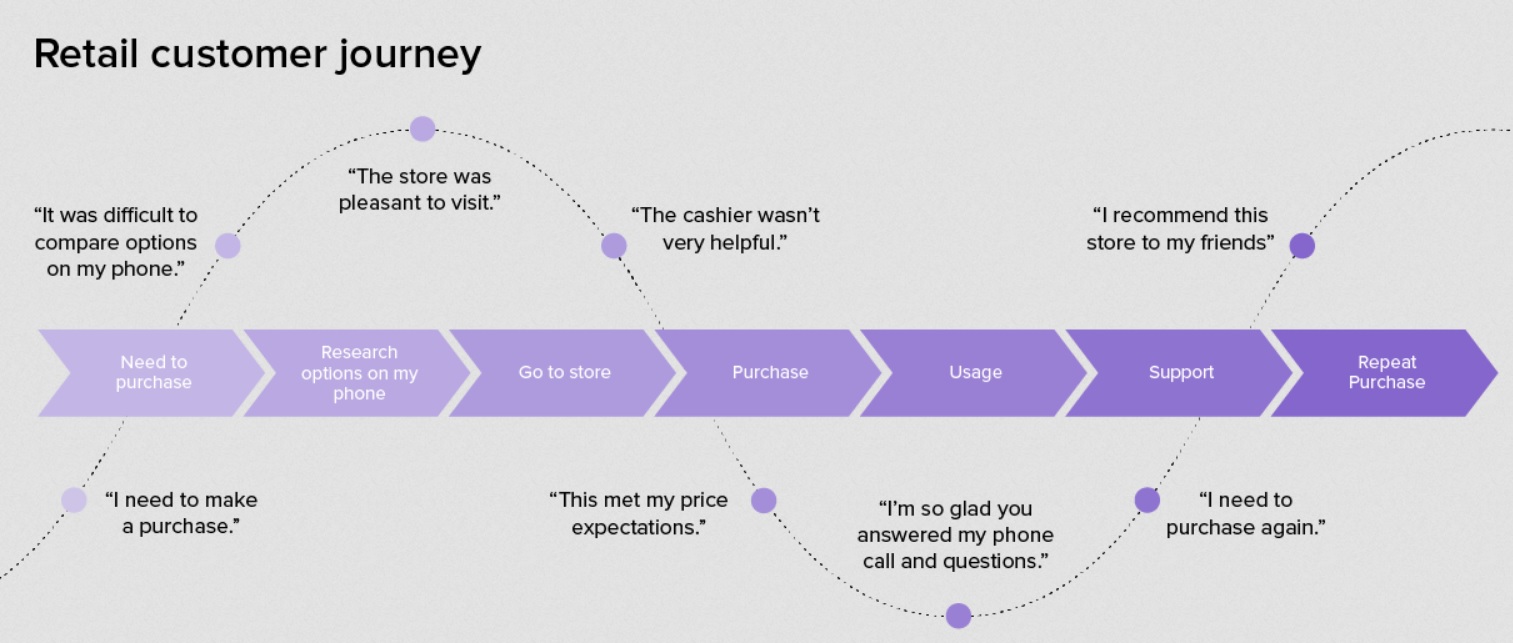
Image via Delighted
Customer journey mapping helps you understand every stage of the customer’s experience. You can find ways to improve experiences by mapping your customers’ journeys. This drives higher conversions and increased loyalty.
How does CRM integration step in to improve customer journey mapping?
Before we begin, let’s discuss the types of data necessary for customer journey mapping. There is solicited and unsolicited customer data.
Solicited data is obtained from customer surveys and feedback. This can help you understand how they interact with your brand. However, unsolicited data can uncover deep insights that customers aren’t telling you directly.
Integrating your CRM with tools like social media listening and chatbots provides a granular view of customer experiences across various data points.
This comprehensive data helps you understand the customers’ journey at a granular level.
6. Better Customer Service
Customer service agents require access to a range of data to make customer interactions exceptional. This includes:
- Basic customer details, such as name, location, and purchase data. These details help the agents personally address each customer
- History of previous inquiries, issues, resolutions, and follow-up actions. It provides them with context during the interaction to avoid asking redundant questions
- In-depth details about the products a customer has purchased to provide relevant assistance
- Details of a customer’s warranties, repairs or maintenance, and returns
Rather than hopping from system to system to access this data, a CRM system integrated with the company’s software acts as a central source of all this data.
An integrated CRM system enables faster response times to customer inquiries and provides all the details needed for personalized customer experiences. It also promotes better team communication across multiple departments, enhancing overall customer satisfaction.
Also Read:
7 Most Crucial CRM Integrations Your Business Should Implement
The CRM integrations you implement for your business depend on your industry, specific needs, and existing business tools.
However, we’ll give you 7 CRM integration examples that can benefit all kinds of businesses.
1. Marketing Automation Software
CRM integration with marketing automation systems is critical. It ensures that the sales and marketing departments work together to bring in more leads and close more sales.
CRM integration provides the marketing team with sales information, such as customer buying behavior and preferences. They can use this data to refine their lead generation and nurturing tactics.
Marketing data helps sales reps launch focused sales initiatives. They can create targeted campaigns based on how customers interact with previous campaigns.
2. Enterprise Resource Planning Software (ERP)
An ERP carries data on critical business functions, such as accounting, project management, supply chain operations, procurement, and more.
Integrating your CRM system with your ERP can have benefits, such as:
- Access for sales teams to view and track inventory levels and product availability in real-time. With this enhanced accessibility, they can provide accurate promise dates to customers and avoid overselling.
- Integrating an ERP system with CRM can lead to more efficient business processes, better connect your company website forms with CRM to capture leads, and leverage customer information from social media channels.
- Improved access for customer service representatives to evaluate integrated data, such as order status, product details, and other relevant information, directly from the CRM system.
- Improved efficiency in order processing. When you enter a sales order into the CRM, it automatically updates the ERP system, triggering inventory adjustments, procurement plans, and production schedules.
3. CRM Integration with Ecommerce Software
Integrate the ecommerce software your business uses to manage sales, such as payment and order management software.
It keeps your customer profiles updated with details of their buying patterns, preferred payment methods, and support activities.
A significant benefit of CRM integration is the automatic creation of profiles for self-converting customers. It captures valuable data about these customers for future marketing and relationship-building efforts.
4. CRM Integration with Your Website
Integrate your website forms with your CRM.
It creates a seamless flow of customer data from your lead generation forms to your CRM. The prospect data in your CRM system remains fresh, accurate, and properly segmented for easier and faster follow-ups.
The integration can also support relevant data flow from your CRM system to your website. It allows you to pre-populate customer forms using data stored in the CRM.
5. CRM Integration with Survey Tools
Integrate your CRM system with your survey tools to make customer sentiments and preferences available to client-facing employees. It provides them with insightful data that they can use to address customers’ concerns proactively.
In addition, it makes it easy to automate follow-up actions based on survey responses. You can initiate a retention strategy for a dissatisfied customer and assign tasks to the customer support team.
6. CRM System Integration with Document Management Systems
Connect your CRM system to your document management system. It can make locating and sharing important files like sales contracts and other proposals easy.
The real-time data sharing from the document management system also ensures that your team works with the latest versions of the business’s documents. This prevents confusion and potential errors.
7. CRM Integration with Social Media Platforms
CRM integration with social media management tools lets your business leverage customer data from social media interactions.
Sales representatives can analyze customers’ online behavior and use these insights to tailor their approach and offerings.
CRM integration with social media management tools can also help your business in the following ways:
- Enriching customer profiles using their social media accounts to create a consistent experience across all touchpoints
- Using social insights to refine segmentation
- Capturing leads from social media interactions
Also Read:
5 Strategies for Effective Integration in CRM Systems
Now that you know why an integrated CRM system is the most crucial system to integrate, what’s next? Learn how to make these integrations.
Out of these 5 methods, your choice will depend on the complexity of the data exchange, system compatibility, and the level of IT resources available.
Let’s see how these five methods work.
1. Get Your Software from a Single Provider
A super-easy CRM integration strategy you can implement is to source most of your services and tools from the same provider.
For instance, you can get Salesforce CRM, Data Cloud, Sales Engagement, and Customer Service Automation. The systems will automatically connect because they are from the same provider.
This strategy reduces the number of custom CRM integrations you need to create.
However, only apply this strategy where the set of tools provided is up to par. You should not prioritize its capability to integrate with the CRM automatically over its quality.
2. Leverage Built-In Integrations
CRM software systems today have built-in connections that integrate your CRM with some popular apps businesses use. This is a convenient solution because you can quickly identify the app you need and integrate it with the click of a button.
See the wide range of built-in integrations that Freshworks offers for ecommerce apps. It’s one of the best CRM software programs on the market.
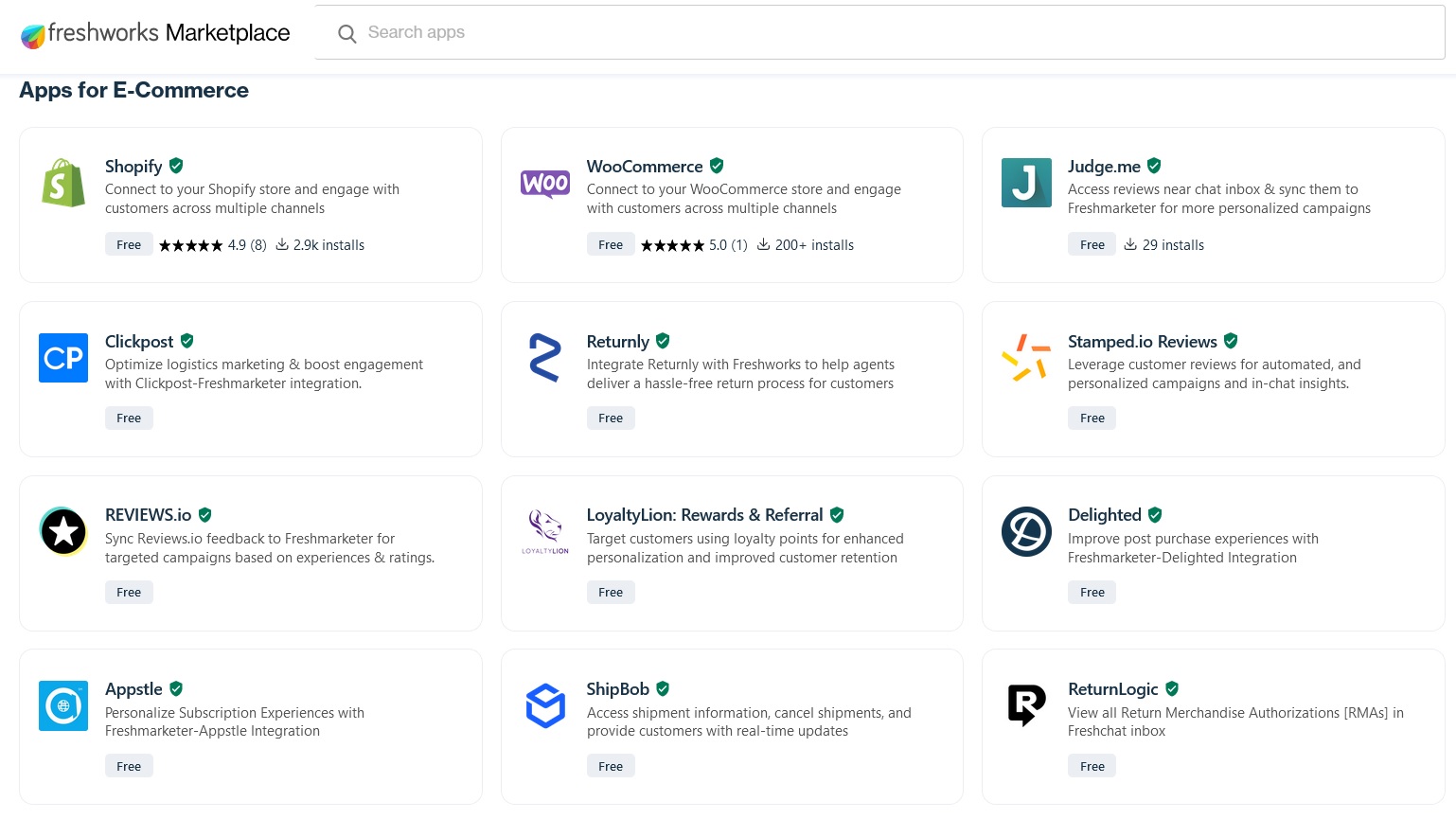
Image via Freshworks
Investing in a CRM system with built-in integrations for your business’s apps is one of the best options for small businesses.
But if the systems you want to integrate are unavailable in the CRM software, use the next best method—building an API connection.
3. Use an Application Programming Interface (API) for CRM Integration
If you can’t use built-in integrations, consider getting system APIs for custom integrations, leveraging CRM integration platform services, and ensuring data accuracy during the CRM integration process.
For context, an API is a software intermediary with endpoints in your CRM and the system you want to integrate. It allows the two systems to talk to each other. It also defines the following:
- How to make requests for certain functionalities or data
- How to structure responses
How does an API integration work? The API request and response process is explained in the context of the client and server.
The software application sending the request to access the data of another application is known as the client. Meanwhile, the application receiving the request is known as the server.
What happens is that the client uses system APIs to send a request to the server. The request is known as an API call, and it includes the action or data the client seeks.
The server receives the request, processes it, and sends a response back to the client.
Using an API connection in CRM integrations has two significant advantages:
- You can customize the data integration. This means you can make the data integration meet specific needs that a standard built-in integration would not allow.
- You can make concurrent data requests from multiple systems. For instance, when you pull a customer profile, data from the payment processor, communications ticket system, and marketing automation system needs to be processed to give a holistic view of customer interactions.
Most CRM systems offer API integrations to connect seamlessly to third-party apps like Pipedrive.

Image via Pipedrive
However, you must ensure that the CRM provides extensive documentation for its API function.
Also Read:
4. Use Integration Platform as a Service (IPaaS)
The fourth CRM integration solution leverages the integration services of an IPaaS.
An IPaaS is a cloud service breed that enables integration among different software systems without extensive on-site infrastructure or custom coding.
The IPaaS offers pre-built connectors and adapters to facilitate CRM integration with various applications.
Here are some reliable IPaaS you can invest in:
- Zapier: Zapier is extremely user-friendly and lets you integrate over 8,000 apps. It’s a no-code IPaaS that enables you to use ready-made CRM integration templates, giving you access to 940+ CRM apps. You can also integrate your apps using webhooks.
- MuleSoft: MuleSoft is a subsidiary of Salesforce. The platform provides a variety of robust, pre-built integration assets, such as connectors and application programming interfaces that you can set up using a drag-and-drop editor. It also helps with API management
- Boomi: Boomi is known for its reliability and speed. It provides reliable performance even in complex integration scenarios. Boomi allows your on-premises integrations to synchronize, even if there’s a break in your internet connection. Moreover, Boomi offers a wide range of pre-built connectors, including one for Microsoft Dynamics, making it easier for you to integrate your CRM with your ERP system.
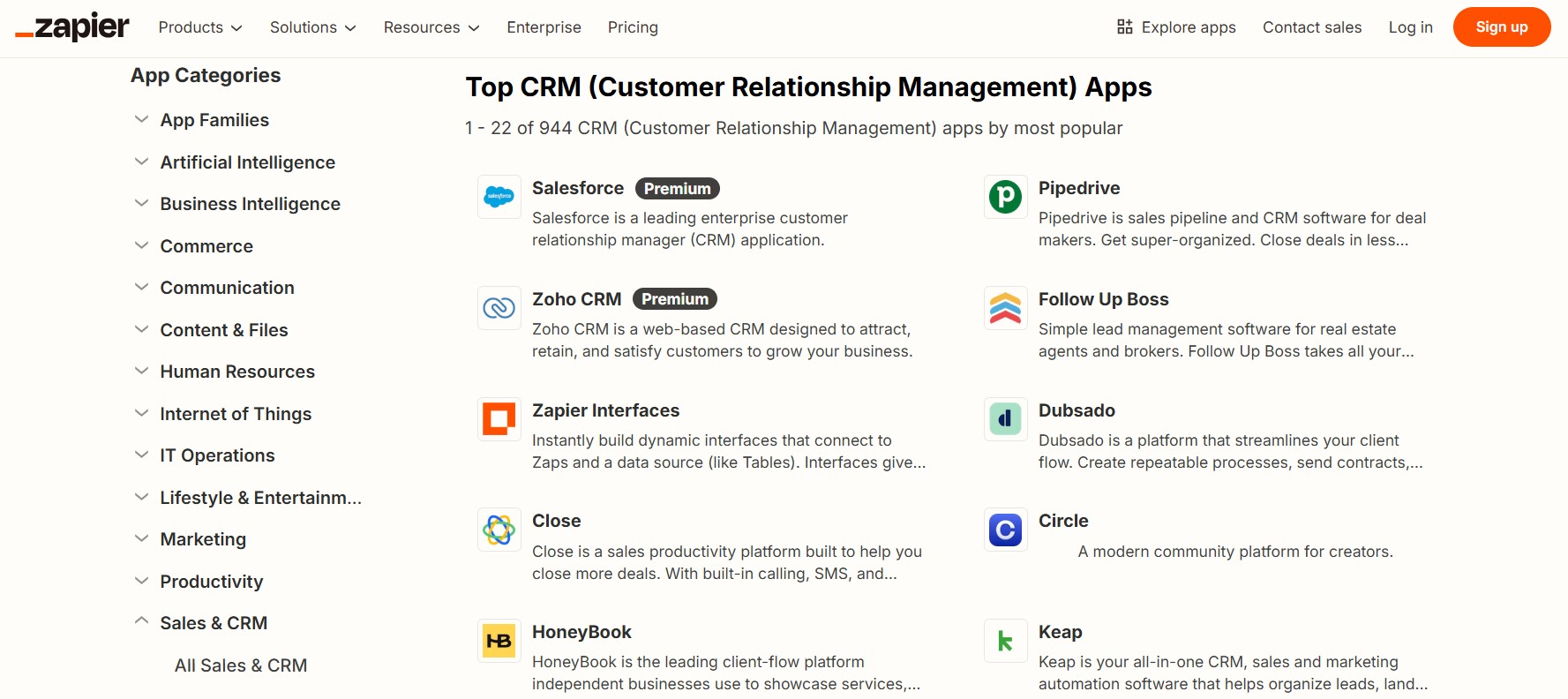
Image via Zapier
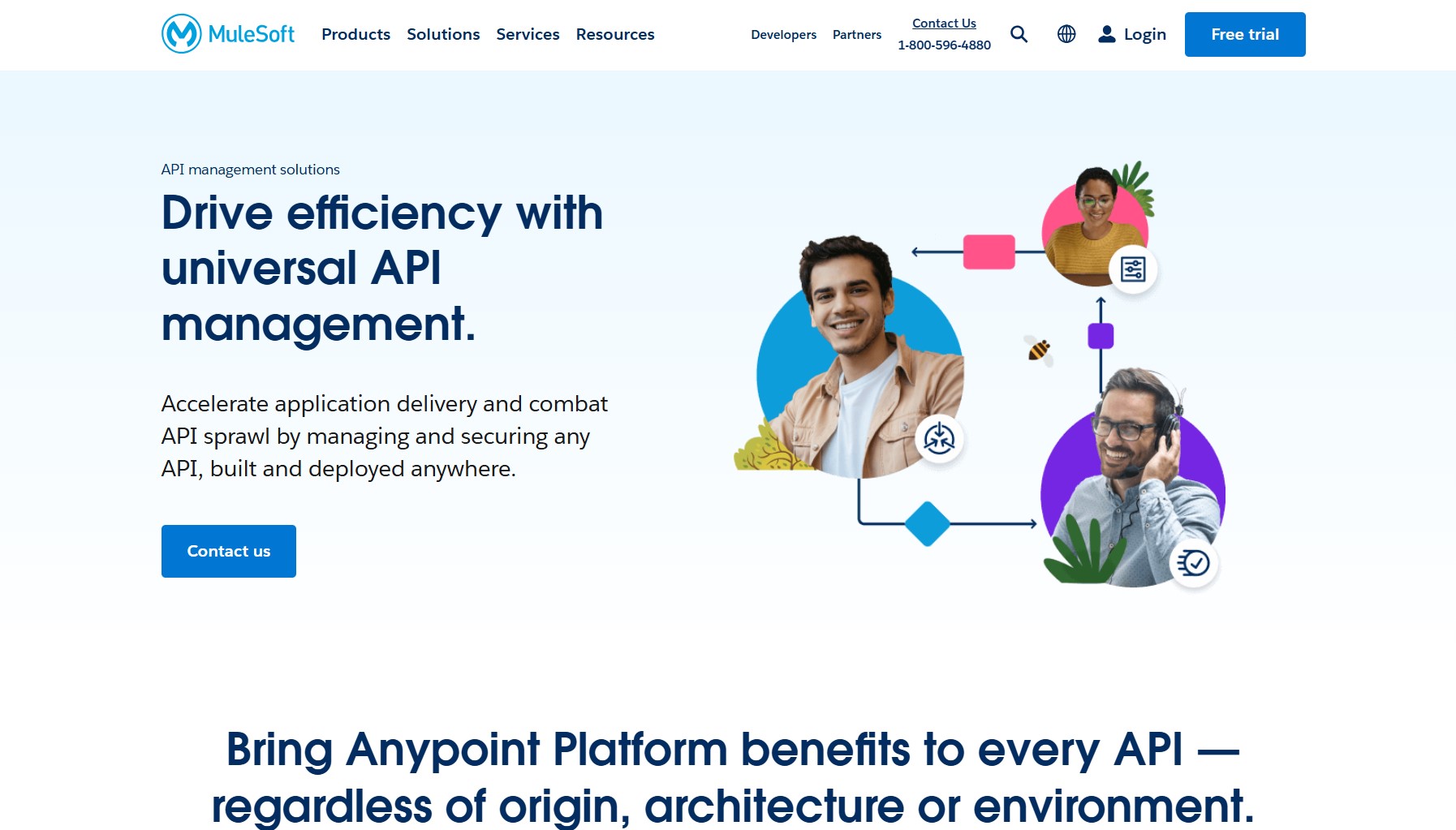
Image via MuleSoft
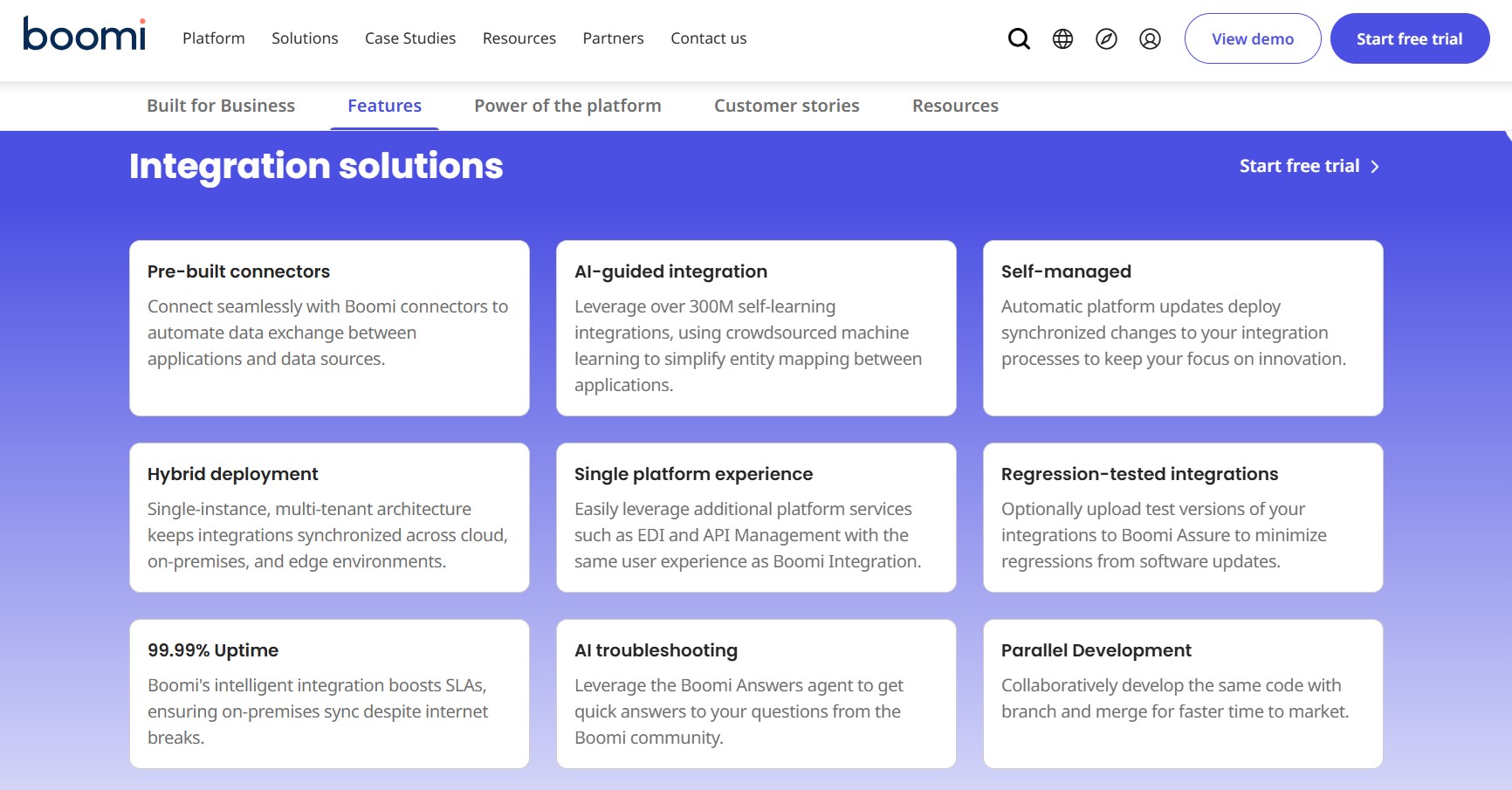
Image via Boomi
5. Write Custom Code
Writing custom code is also viable for creating CRM integrations. A developer can write lines of code that force your CRM to communicate with your systems.
It is handy when you have highly specialized and complex integration needs, such as unique workflows and data models.
Custom code means you have control over the performance optimization of the integration. You can maximize the overall speed and efficiency of data transfers.
On the other hand, it can be both time-consuming and expensive. You’ll need a team of in-house CRM software developers to keep up with the constant updates and changes necessary to keep the integration going smoothly.
Additionally, the development process takes longer compared to using pre-built integration tools.
Also Read:
6 Best Practices for a Better CRM Integration Strategy
You can enhance the success of your CRM integration and create a more seamless and efficient workflow within your organization by applying these 6 tips.
1. Ensure You Have the Right CRM
You need to invest in the right CRM tools to succeed with your integrations. These are the features such a CRM system should have:
- Scalability: It should be capable of accommodating additional CRM users and high data volumes without a decline in its efficiency
- Built-in integration: The CRM software should integrate with some of the popular apps businesses use, such as Wix, Shopify, WooCommerce, BigCommerce, and Google Analytics
- Advanced CRM integration tools: In addition to the built-in integrations, it should support API integration or connectors
- User-friendliness: CRM integration extends the capabilities of the tool. It needs a user-friendly interface to help users navigate these additional functionalities easily
- Reliable customer support: It’s important to have access to a responsive customer support team. You may need them to clarify doubts about the integration processes, troubleshoot technical glitches, or provide guidance on optimizing the integrated CRM software solution
These features impact the effectiveness and success of your integration strategy.
2. Plan the Integration Processes and Workflows
This is one of the critical CRM best practices for making your data integration work properly.
Create a detailed plan that outlines how data and processes will flow between multiple systems as part of the integration.
This plan should define:
- The kinds of interactions that will occur between your CRM system and other applications
- The data elements that will synchronize between the CRM and the systems
- The frequency of the data exchange and whether it’ll be one-way or two-way
- The events or actions that will trigger data transfer or synchronization
- The order in which data will be transferred, transformed, and validated
- Access controls, encryption methods, and authentication mechanisms to safeguard information
Having a clear plan for implementing the CRM integration process reduces the risk of errors and supports seamless user adoption.
It also minimizes disruptions to regular business operations during the implementation phase.
3. Conduct a Comprehensive Data Audit
Assess the quality of your existing data before the CRM integration. Accurate data is essential to a smooth integration process and maintaining the effectiveness of your CRM software tool.
To assess the quality of your data, identify the following:
- Address incomplete information and redundancies to avoid integration errors
- Standardize inconsistencies in data format and structure
- How data in your existing systems corresponds to the data structure and requirements of the CRM, facilitating a more accurate mapping process
- If the data meets compliance and security requirements, especially sensitive customer information
Addressing data issues minimizes the chances of encountering unexpected challenges during the integration process.
Also Read:
4. Back Up Your Application Data
Back up all your CRM data before integrating your CRM with other systems. This way, if the data is lost or corrupted during the transfer, you can restore it to its pre-integration state.
There are several methods you can use to back up your application data:
- Use cloud storage, such as Google Drive, iCloud, and Dropbox
- Use the built-in backup mechanism in the app
- Use an external hard drive
We recommend following the 3-2-1 backup rule for CRM integration purposes and the safety of all your data.
This is what it stipulates:
- 3: Have three backups—one primary backup and two extra copies of the data
- 2: The backups should be in two different types of media
- 1: At least one backup should be offsite
Don’t just back up your data at the beginning of the integration; make it frequent.
Set an automated and regular backup schedule based on the rate of data changes in your systems and the criticality of the information they hold. It can be daily, hourly, weekly, or as you see fit.
5. Train Your Staff
Proper data handling is essential for a secure and effective CRM integration. You need clear safeguards to protect customer data and maintain trust.
Here’s how to ensure your data remains clean, secure, and compliant during CRM integration:
- Implement role-based access control: Limit who can view or edit customer data based on job responsibilities
- Use encryption in transit and at rest: Secure all sensitive information shared across integrated systems
- Conduct regular data clean-ups: Eliminate duplicates, validate contact details, and remove outdated entries
- Perform third-party risk assessments: Vet all external tools for security certifications and data compliance (e.g., GDPR, CCPA)
- Automate data backups: Schedule frequent data backups to prevent loss or corruption during syncing
- Train staff on data security: Ensure your team understands safe data handling and privacy protocols
Treating data security as a core part of CRM integration protects your systems, keeps you compliant, and builds long-term customer confidence.
6. Train Your Staff
Failing to train staff is one of small businesses’ most common CRM mistakes. Training becomes even more important when you integrate with different systems.
Provide adequate training for users interacting with the integrated software to maximize your CRM investment. Adequate training will have several benefits for your CRM integration strategy, such as:
- When users know how to use the extended functionality, it maximizes the benefits of the CRM integration
- It reduces the learning curve associated with the changes to the CRM software
- Once they know how the CRM integration fits into their daily workflow and improves it, employees are more likely to embrace the change
7. Measure Success
It’s important to analyze if your CRM integration brings in the specific benefits you had in mind.
To achieve this, be clear on your objectives first. What do you want the CRM integration to do for your business? Should it improve customer service delivery? Increase sales efficiency? You have to state what you want to achieve.
Next, set metrics that you’ll use to measure these objectives. A few practical examples are:
- Time to resolution (TTR)
- Sales revenue
- Net promoter score (NPS)
Regularly monitor these metrics to evaluate the effectiveness of your integration strategy. Then, make adjustments, like adding more data elements, integrating different systems, or encouraging higher user adoption.
Common CRM Integration Challenges and How to Overcome Them
Even with careful planning, CRM integration projects often encounter obstacles that can derail implementation timelines. These challenges may reduce user adoption or even compromise data quality and results if not addressed early.
Anticipating potential issues and knowing how to solve them can help you stay on track and avoid costly setbacks. Here are some of the most common CRM integration challenges and their solutions:
- Data quality and consistency issues: Clean your data before integration, establish data validation rules, and create standardized data entry protocols across all connected systems
- User resistance and adoption problems: Involve users early, highlight how the CRM supports specific workflows, provide hands-on training, and consider gradually rolling out implementation
- Compatibility issues with third-party apps: Choose integrations that are tested and supported, use middleware solutions, or work with developers to build reliable custom connectors
- Integration downtime or sync failures: Conduct thorough load testing before full deployment, use robust middleware, schedule syncs during low-traffic hours, and monitor performance with alerts
- Budget overruns and timeline delays: Set realistic expectations by establishing detailed project scoping, assigning resources for continuous monitoring, and maintaining contingency funds for unexpected complications
Overcoming these challenges is key to realizing the full value of your CRM integration. With the right preparation and support, even complex integrations can lead to seamless, scalable growth.
Also Read:
FAQ
Q1. How do I integrate a CRM into a website?
An API connection is the best way to streamline CRM integration, allowing for a seamless connection from your CRM platform to your website. Get an IT expert to make the API connection for you. You can also use a pre-built connector from an IPaaS.
It allows for the real-time exchange of data between your website and CRM.
Q2. What is an example of a CRM?
Some examples of CRM tools that support seamless integrations are Salesforce, HubSpot, and Freshworks.
Q3. What is a CRM and how does it work?
CRM stands for customer relationship manager. It is a software tool designed to help businesses manage customer relationships across all customer lifecycle stages.
CRM systems offer a variety of functionalities. However, most CRM systems provide the basic functions, such as:
- Manage customer data
- Automate workflows
- Automate repetitive tasks
- Provide customer insights through analytics
Q4. What is CRM API integration?
A CRM API integration connects CRM and third-party applications using an application programming interface. It allows seamless data exchange and collaboration between the CRM system and the other software, enhancing its functionality.
Q5. What is ERP and CRM integration?
CRM integration with ERP systems involves connecting your CRM platform to your ERP system. It synchronizes data in the two systems and provides a comprehensive view of customer information and overall business processes.
Q6. How can I ensure a smooth CRM integration process?
Implementing CRM integrations can be complex. However, there are some things you can do to make the process a lot smoother. Here are a few of them:
- Clearly define your integration goals and requirements, considering the specific needs of your sales team and other departments.
- Choose a CRM platform that offers robust integration capabilities, such as pre-built connectors and APIs.
- Before starting the integration process, clean and standardize your data to ensure accuracy and consistency across all systems.
- Provide thorough training and support to your sales team and other users to ensure they understand how to leverage the integrated systems effectively.
Q7. What is a CRM integration strategy?
Yes, CRM integration with social media solutions is possible. All you have to do is integrate your social media management system with your own CRM software. It’ll allow your CRM to access data on how customers interact with your brand on social media.
Conclusion: Implement a Powerful CRM Integration Strategy Today
We’ve helped you understand CRM integration and all the basics you need to get started with your CRM integration strategy.
Choosing your CRM platform is the most essential part of getting it right. Pay attention to its integration capabilities, user-friendliness, scalability, and customer support.
Likewise, take the time to prepare for the integration. A well-planned CRM system integration strategy can streamline manual processes, enhance customer experiences, and drive future sales through repeat purchases.
You can create a well-planned CRM integration strategy by conducting a thorough data audit, training your staff, and backing up your data frequently.
Once you’ve integrated the systems, measure if they bring in the desired outcomes.











